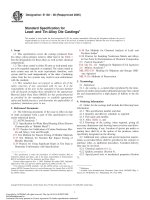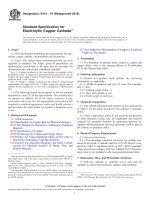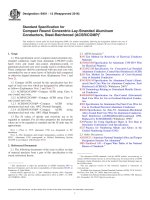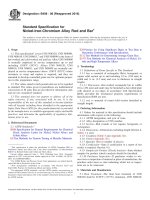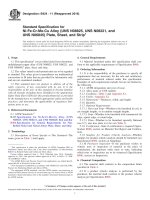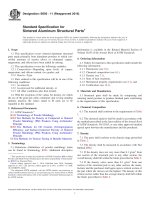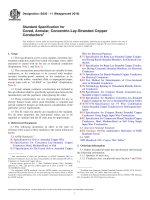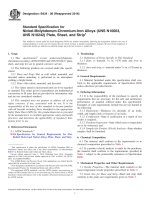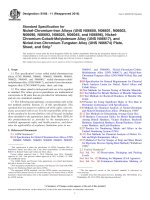Astm b 758 00 (2016)
Bạn đang xem bản rút gọn của tài liệu. Xem và tải ngay bản đầy đủ của tài liệu tại đây (97.71 KB, 5 trang )
Designation: B758 − 00 (Reapproved 2016)
Standard Specification for
Nickel-Chromium-Molybdenum-Tungsten Alloys
(UNS N06110) Welded Tube1
This standard is issued under the fixed designation B758; the number immediately following the designation indicates the year of
original adoption or, in the case of revision, the year of last revision. A number in parentheses indicates the year of last reapproval. A
superscript epsilon (´) indicates an editorial change since the last revision or reapproval.
E38 Methods for Chemical Analysis of Nickel-Chromium
and Nickel-Chromium-Iron Alloys (Withdrawn 1989)4
E213 Practice for Ultrasonic Testing of Metal Pipe and
Tubing
E354 Test Methods for Chemical Analysis of HighTemperature, Electrical, Magnetic, and Other Similar Iron,
Nickel, and Cobalt Alloys
E527 Practice for Numbering Metals and Alloys in the
Unified Numbering System (UNS)
E571 Practice for Electromagnetic (Eddy-Current) Examination of Nickel and Nickel Alloy Tubular Products
1. Scope
2
1.1 This specification covers welded UNS N06110 tube in
the annealed condition (temper) for general corrosion applications.
1.2 This specification covers outside diameter and nominal
wall tube.
1.2.1 The tube sizes covered by this specification are 1⁄8 to 5
in. (3.2 to 127 mm) in outside diameter and 0.015 to 0.148 in.
(0.4 to 3.8 mm), inclusive, in wall thickness.
1.3 The values stated in inch-pound units are to be regarded
as the standard. The SI units in parentheses are provided for
information only.
1.4 The following precautionary caveat pertains only to the
test method portion, Section 13, of this specification: This
standard does not purport to address all of the safety concerns,
if any, associated with its use. It is the responsibility of the user
of this standard to become familiar with all hazards including
those identified in the appropriate Safety Data Sheet (SDS) for
this product/material as provided by the manufacturer, to
establish appropriate safety and health practices, and determine the applicability of regulatory limitations prior to use.
3. Classification
3.1 Class 1—Welded, cold-worked, annealed, and nondestructively tested in accordance with 11.5.1.
3.2 Class 2—Welded, cold-worked, annealed, and nondestructively tested in accordance with 11.5.2.
4. Ordering Information
4.1 Orders for material conforming to this specification
shall include the following information:
4.1.1 Alloy name or UNS number.
4.1.2 ASTM designation and year of issue.
4.1.3 Dimensions:
4.1.3.1 Outside diameter and nominal wall thickness.
2. Referenced Documents
2.1 ASTM Standards:3
E8 Test Methods for Tension Testing of Metallic Materials
E29 Practice for Using Significant Digits in Test Data to
Determine Conformance with Specifications
NOTE 1—Tube produced to outside diameter and minimum wall may be
furnished upon agreement between the manufacturer and the purchaser.
4.1.3.2 Length (specific or random).
4.1.4 Class (see 11.5).
4.1.5 Quantity (feet or number of pieces).
4.1.6 Certification—State if certification is required (Section 16).
4.1.7 Samples for Product (Check) Analysis—State whether
samples for product (check) analysis should be furnished
(10.2).
1
This specification is under the jurisdiction of ASTM Committee B02 on
Nonferrous Metals and Alloys and is the direct responsibility of Subcommittee
B02.07 on Refined Nickel and Cobalt and Their Alloys.
Current edition approved June 1, 2016. Published June 2016. Originally
approved in 1986. Last previous edition approved in 2011 as B758 – 00 (2011).
DOI: 10.1520/B0758-00R16.
2
New designation established in accordance with Practice E527 and SAE J1086,
Recommended Practice for Numbering Metals and Alloys (UNS).
3
For referenced ASTM standards, visit the ASTM website, www.astm.org, or
contact ASTM Customer Service at For Annual Book of ASTM
Standards volume information, refer to the standard’s Document Summary page on
the ASTM website.
4
The last approved version of this historical standard is referenced on
www.astm.org.
Copyright © ASTM International, 100 Barr Harbor Drive, PO Box C700, West Conshohocken, PA 19428-2959. United States
1
B758 − 00 (2016)
TABLE 2 Product (Check) Analysis Chemical Composition
Variations
4.1.8 Purchaser Inspection—If purchaser wishes to witness
tests or inspection of material at place of manufacture, the
purchase order must so state indicating which tests or inspections are to be witnessed (Section 14).
Specified Limit of
Element %
Element
5. Material and Manufacture
Nickel
5.1 Tube shall be made from flat-rolled alloy by an automatic welding process with no addition of filler metal. Subsequent to welding and prior to final annealing, the material shall
be cold-worked in either the weld metal only or both weld and
base metal.
Tungsten
Iron
Manganese
Carbon
Silicon
5.2 Tube shall be furnished with oxide removed. When
bright annealing is used, descaling is not necessary.
Sulfur
Chromium
Aluminum
6. Chemical Composition
Titanium
6.1 The material shall conform to the composition limits
specified in Table 1.
Columbium +
Tantalum
Molybdenum
Phosphorus
6.2 If a product (check) analysis is performed by the
purchaser, the material shall conform to the product (check)
analysis variations in Table 2.
7.1 Mechanical Properties—The material shall conform to
the mechanical properties specified in Table 3.
Alloy
7.2 Flattening Test—A section of tube not less than 4 in.
(102 mm) in length shall be capable of withstanding, without
cracking, flattening under a load applied gradually at room
temperature until the distance between the platens is five times
the wall thickness. The weld shall be positioned 90° from the
direction of the applied flattening force.
7.2.1 Superficial ruptures resulting from surface imperfections shall not be a cause for rejection.
UNS N06110
Fe
Al
Ti
W
NiA
Cu
A
over 5.0 to 20.0, incl
up to 0.04, incl
0.15
0.005
Composition
Limits, %
Product (Check)
Analysis Variations under min
or over max, of
the Specified
Limit of Element
0.15 max
1.0 max
1.0 max
0.015 max
0.015 max
28.0 min
33.0 max
1.0 max
1.0 max
9.0 min
12.0 max
1.0 max
1.0 max
1.0 max
1.0 min
4.0 max
51.0 min
0.5 max
0.01
0.05
0.05
0.005
0.003
0.25
0.25
0.05
0.05
0.15
0.15
0.07
0.05
0.05
0.10
0.10
0.35
0.03
Tensile Strength
min, psi
(MPa)
95 000 (655)
Yield Strength
0.2 % offset
min, psi
(MPa)
45 000 (310)
Elongation
in 2 in. or
50 mm,
min, %
60
7.4 Nondestructive Test Requirements—Tube shall be subjected to nondestructive tests (see 13.2) at the manufacturer’s
option.
7.4.1 For ultrasonic testing, a longitudinal calibration notch
shall be made on the outside diameter and inside diameter. The
depth of the notch shall not exceed 121⁄2 % of the specified wall
thickness of the material or 0.004 in. (0.10 mm), whichever is
greater. Place the notch in the weld if visible.
7.4.2 Acceptance and Rejection—Material producing a signal equal to or greater than the calibration imperfections shall
be subject to rejection.
7.4.2.1 Test signals produced by imperfections that cannot
be identified or produced by cracks or crack-like imperfections
shall result in rejection of the tube, subject to rework and retest.
To be accepted, the material shall pass the same electric test to
which it was originally subjected provided that the dimensional
requirements are met.
7.4.2.2 If the imperfection is judged as injurious, the tube
shall be rejected but may be reconditioned and retested
providing the dimensional requirements are met. To be
accepted, retested material shall meet the original electric test
requirements.
7.4.2.3 If the imperfection is explored to the extent that it
can be identified as noninjurious, the material may be accepted
without further test provided the imperfection does not encroach on the minimum wall thickness.
TABLE 1 Chemical Requirements
Cb
Co (if determined)
Mo
0.25
0.30
0.04
0.05
0.03
0.01
0.03
0.05
0.003
0.25
0.05
0.10
0.03
0.04
0.04
tube without through-wall cracking. The width of the flange
shall not be less than 15 % of the tube diameter.
7.3 Flange Test—A section of tube shall be capable of
having a flange turned over at a right angle to the body of the
C
Mn
Si
P
S
Cr
over 20.00 to 30.00, incl
over 30.00 to 40.00, incl
over 1.00 to 4.00, incl
over 0.75 to 2.50, incl
up to 1.00, incl
up to 0.20, incl
over 0.25 to 0.50, incl
over 0.50 to 1.00, incl
up to 0.02, incl
over 25.00 to 35.00, incl
over 0.10 to 0.50, incl
over 0.50 to 1.00, incl
over 0.10 to 0.50, incl
over 0.50 to 1.00, incl
up to 1.0, incl
TABLE 3 Mechanical Property Requirements
7. Mechanical and Other Properties
Element
Variation under
min or over
max of the
Specified Limit
of Element
Element shall be determined arithmetically by difference.
2
B758 − 00 (2016)
TABLE 4 Permissible Variations in Outside DiameterA and Wall Thickness
Permissible Variations
Specified Outside Diameter, in.
(mm)
Outside Diameter, in. (mm)B
⁄ (3.2) to 5⁄8 (15.9), excl
5⁄8 (15.9) to 11⁄2 (38.1), incl
Over 11⁄2 (38.1) to 31⁄2 (88.9), incl
Over 31⁄2 (88.9) to 41⁄2 (114.3), incl
Over 41⁄2 (114.3) to 5 (127), incl
18
Wall Thickness, %
Plus
Minus
Plus
Minus
0.005 (0.13)
0.0075 (0.19)
0.010 (0.25)
0.015 (0.38)
0.020 (0.51)
0.005 (0.13)
0.0075 (0.19)
0.010 (0.25)
0.015 (0.38)
0.020 (0.51)
12.5
10.0
10.0
10.0
12.5
12.5
10.0
10.0
10.0
12.5
A
These permissible variations in outside diameter apply only to material as finished at the mill before subsequent swaging, expanding, bending, polishing, or other
fabricating operations.
Ovality is the difference between maximum and minimum outside diameter measured at any one cross section. There is no additional tolerance for ovality on material
having a nominal wall thickness of more than 3 % of the outside diameter. On this material, the average of maximum and minimum outside diameter measurements will
fall within the outside diameter tolerance shown in the table above. An additional ovality allowance of twice the outside diameter tolerance spreads shown above, applied
one half plus and one half minus, is allowed for material having nominal wall thickness of 3 % or less of nominal outside diameter.
B
8. Dimensions and Permissible Variations
10.2.2 Mechanical Properties, Flattening, and Flange
Testing—Samples of the material to provide test specimens
shall be taken from such locations in each lot as to be
representative of that lot.
8.1 Diameter and Wall Thickness—Outside diameter and
nominal wall thickness shall not exceed the permissible variations prescribed in Table 4.
8.1.1 Material having a specified wall thickness that is 3 %,
or less, of the outside diameter cannot be straightened properly
without a certain amount of ovality resulting in the diameter.
The limits to this ovality are stated in Footnote B to Table 4.
11. Number of Tests
11.1 Chemical Analysis—One test per lot.
11.2 Mechanical Properties—One test per lot.
8.2 Straightness—Material shall be reasonably straight and
free of bends or kinks.
11.3 Flattening—One test per lot.
11.4 Flange—One test per lot.
8.3 Length—Variations from the specified length shall not
exceed the amounts prescribed in Table 5.
11.5 Nondestructive Tests:
11.5.1 Class 1—Each piece in each lot shall be subjected to
one of the following four tests: hydrostatic, pneumatic (air
underwater), eddy current, or ultrasonic.
11.5.2 Class 2—Each piece in each lot shall be subjected to
a leak test and an electric test as follows:
11.5.2.1 Leak Test—Hydrostatic or pneumatic (air underwater).
11.5.2.2 Electric Test—Eddy current or ultrasonic.
11.5.3 The manufacturer shall have the option to test to
Class 1 or 2 and select the nondestructive test methods, if not
specified by the purchaser.
9. Workmanship, Finish, and Appearance
9.1 The material shall be uniform in quality and temper,
smooth, commercially straight, and free of injurious imperfections.
10. Sampling
10.1 Lot Definition:
10.1.1 A lot for chemical analysis shall consist of one heat.
10.1.2 A lot for mechanical properties, flattening, and flange
testing shall consist of all material from the same heat, nominal
size (excepting length), and condition (temper).
10.2 Test Material Selection:
10.2.1 Chemical Analysis—Representative samples from
each lot shall be taken during pouring or subsequent processing.
10.2.1.1 Product (check) analysis shall be wholly the responsibility of the purchaser.
12. Specimen Preparation
12.1 Tension test specimens shall be taken from material in
the final condition (temper) and tested in the direction of
fabrication.
12.1.1 Whenever possible, all material shall be tested in full
tubular size. When testing in full tubular size is not possible,
longitudinal strip specimens shall be used. In the event of
disagreement when full tubular testing is not possible, a
longitudinal strip specimen with reduced gage length as
contained in Test Methods E8 shall be used.
TABLE 5 Permissible Variations in LengthA
Outside Diameter
in. (mm)
Under 2 (50.8)
2 (50.8) and over
Cut Length, in.
(mm)
Over
⁄ (3)
3⁄16 (5)
18
Under
0
0
13. Test Methods
13.1 The chemical composition, mechanical, and other
properties of the material as enumerated in this specification
shall be determined, in case of disagreement, in accordance
with the following methods:
A
These permissible variations in length apply to tube before bending. They apply
to cut lengths up to and including 24 ft (7.3 m). For lengths over 24 ft, an additional
over-tolerance of 1⁄8 in. (3 mm) for each 10 ft (3.0 m) or fraction thereof shall be
permissible up to a maximum additional over-tolerance of 1⁄2 in. (12.7 mm).
3
B758 − 00 (2016)
Test
Chemical analysis
Tension
Rounding procedure
A
calculated value, shall be rounded as indicated below, in
accordance with the rounding method of Practice E29:
ASTM Designation
E8, E354A
E8
E29
Rounded Unit for Observed or
Calculated Value
Test
Methods E38 is to be used only for elements not covered by Test Methods E354.
Chemical composition and
tolerances (when expressed in
decimals)
13.2 Nondestructive Tests:
13.2.1 Hydrostatic Test—Test each piece at a pressure not
exceeding 1000 psi (6.9 MPa), calculated as follows:
P 5 2St/D, or
(1)
S 5 PD/2t
(2)
Tensile strength, yield strength
Elongation
Nearest unit in the last right-hand place of
figures of the specified limit. If two choices
are possible, as when the digits dropped are
exactly a 5 or a 5 followed only by zeros,
choose the one ending in an even digit, with
zero defined as an even digit.
Nearest 1000 psi (6.9 MPa)
Nearest 1 %
where:
P = hydrostatic test pressure, psi or MPa;
S = allowable fiber stress as follows: UNS N06110-35000
psi (242 MPa);
t = specified wall thickness in. or mm; and
D = specified outside diameter, in. or mm.
14. Inspection
13.2.1.1 Hold the test pressure for a minimum of 5 s.
13.2.1.2 Make visual examination when the material is
under pressure. Examine the full length of material for leaks. If
any tube shows leaks during the hydrostatic test, reject it.
13.2.2 Pneumatic (Air Underwater) Test—Test each piece at
a pressure of 150 psi (1.05 MPa).
13.2.2.1 Hold the test pressure for a minimum of 5 s.
13.2.2.2 Make visual examination when the material is
submerged and is under pressure. Examine the full length of
material for leaks. If any piece shows leaks during the test,
reject it.
13.2.3 Electric Test—Give each tube an electric test in
accordance with either Practice E213 or Practice E571. For
eddy-current testing, the calibration tube shall contain, at the
option of the producer, any of the following discontinuities to
establish a minimum sensitivity level for rejection. The discontinuity shall be placed in the weld if visible.
13.2.3.1 Drilled Hole—Drill a hole, not larger than 0.031-in.
(0.79-mm) diameter radially and completely through the wall,
taking care to avoid distortion of the material while drilling.
13.2.3.2 Transverse Tangential Notch—Using a round file or
tool with a 1⁄4-in. (6.4 mm) diameter, file or mill a notch
tangential to the surface and transverse to the longitudinal axis
of the material. Said notch shall have a depth not exceeding
121⁄2 % of the specified wall thickness of the material or 0.004
in. (0.102 mm), whichever is greater.
13.2.3.3 Longitudinal Notch—Machine a notch 0.031 in.
(0.79 mm) or less in width in a radical plane parallel to the
material axis on the outside surface of the tube to have a depth
not exceeding 121⁄2 % of the specified wall thickness of the
material or 0.004 in. (0.102 mm), whichever is greater. The
length of the notch shall be compatible with the testing method.
15.1 Material that fails to conform to the requirements of
this specification may be rejected. Rejection should be reported
to the producer or supplier promptly and in writing. In case of
dissatisfaction with the results of the test, the producer or
supplier may make claim for a rehearing.
14.1 Inspection of the material shall be agreed upon between the purchaser and the supplier as part of the purchaser
contract.
15. Rejection and Rehearing
16. Certification
16.1 Upon request of the purchaser in the contract or order,
a manufacturer’s certification that the material was manufactured and tested in accordance with this specification together
with a report of the test results shall be furnished.
17. Product Marking
17.1 Material—The name or brand of the manufacturer, the
trade name of the material or UNS number, the letters ASTM,
the specification number, heat number, class and nominal size
shall be legibly stenciled on each piece 1⁄2 in. (12.7 mm) and
over in outside diameter, provided the length is not under 3 ft
(914 mm). The material marking shall be by any method that
will not result in harmful contamination.
17.1.1 For material less than 1⁄2 in. in outside diameter and
material under 3 ft in length, the information specified in 17.1
shall be either stenciled or marked on a tag securely attached to
the bundle or box in which the tube is shipped.
17.2 Packaging—Each bundle or shipping container shall
be marked with the name or brand of the manufacturer, the
trade name of the material or UNS number, the letters ASTM,
this specification number, heat number, class, and nominal size;
gross, tare, and net weight; consignor and consignee address;
contract or order number; or such other information as may be
defined in the contract or order.
18. Keywords
13.3 Rounding Method—For the purpose of determining
compliance with the specified limits for requirements of the
properties listed in the following table, an observed value, or a
18.1 nickel-chromium-molybdenum-tungsten;
N06110; welded tube
4
UNS
B758 − 00 (2016)
ASTM International takes no position respecting the validity of any patent rights asserted in connection with any item mentioned
in this standard. Users of this standard are expressly advised that determination of the validity of any such patent rights, and the risk
of infringement of such rights, are entirely their own responsibility.
This standard is subject to revision at any time by the responsible technical committee and must be reviewed every five years and
if not revised, either reapproved or withdrawn. Your comments are invited either for revision of this standard or for additional standards
and should be addressed to ASTM International Headquarters. Your comments will receive careful consideration at a meeting of the
responsible technical committee, which you may attend. If you feel that your comments have not received a fair hearing you should
make your views known to the ASTM Committee on Standards, at the address shown below.
This standard is copyrighted by ASTM International, 100 Barr Harbor Drive, PO Box C700, West Conshohocken, PA 19428-2959,
United States. Individual reprints (single or multiple copies) of this standard may be obtained by contacting ASTM at the above
address or at 610-832-9585 (phone), 610-832-9555 (fax), or (e-mail); or through the ASTM website
(www.astm.org). Permission rights to photocopy the standard may also be secured from the Copyright Clearance Center, 222
Rosewood Drive, Danvers, MA 01923, Tel: (978) 646-2600; />
5
